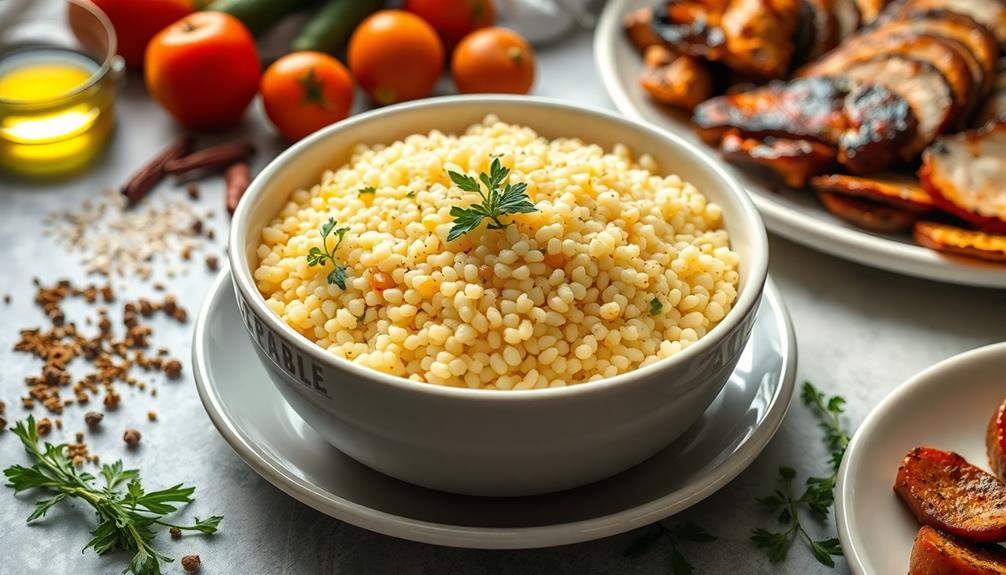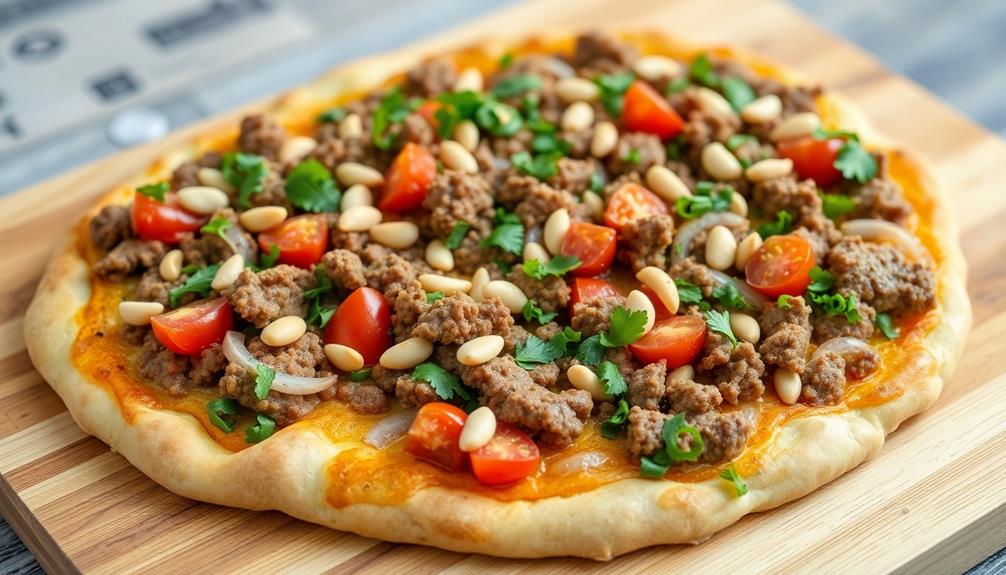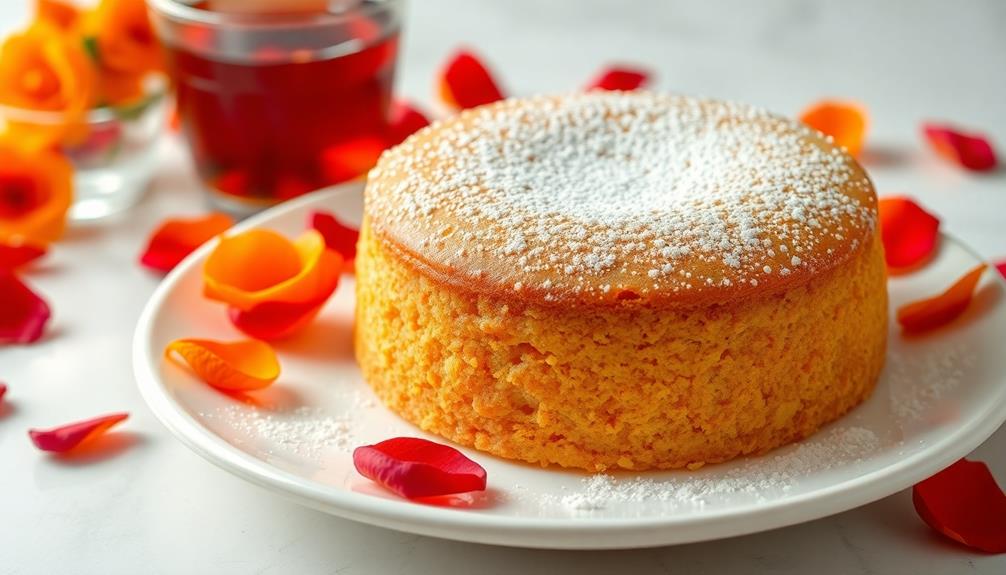Moghrabieh, also known as Lebanese couscous, is a unique and delectable dish that reflects the diverse cultural influences of the Levant region. Originating from the Arabic word "Maghreb," which refers to North Africa, moghrabieh is a melting pot of Mediterranean and Middle Eastern flavors. This traditional dish has nourished families for generations, showcasing Lebanon's vibrant food traditions. Preparing moghrabieh involves soaking, rinsing, and sautéing aromatic ingredients like onions, garlic, and spices, before combining with chickpeas and the cooked couscous-like grains. The result is a chewy, nutty, and savory delight that will leave you eager to explore more of Lebanese cuisine.
Key Takeaways
- Moghrabieh is a traditional Lebanese dish that reflects the diverse cultural influences of the Levant region, with connections to North African cuisines.
- The dish is prepared by soaking and rinsing the moghrabieh (Lebanese couscous) grains, then sautéing onions, garlic, and spices before adding chickpeas and the cooked grains.
- The unique chewy texture and nutty flavor of moghrabieh complement the savory ingredients, making it a versatile addition to Lebanese cuisine that can be enjoyed as a side dish or main course.
- Proper preparation, including overnight soaking and rinsing the moghrabieh grains, is crucial to ensure even cooking and remove excess starch.
- Moghrabieh represents Lebanon's vibrant food traditions and offers opportunities for experimentation with various mix-ins and toppings to create unique and delightful culinary experiences.
History
Moghrabieh, a beloved staple of Lebanese cuisine, has its roots woven deep into the region's rich culinary tapestry. This traditional Lebanese couscous dish has been nourishing families for generations, passed down through the ages with love and care.
The origins of moghrabieh can be traced back to the Levant, where the distinct flavors and textures of this dish have evolved over time, reflecting the diverse cultural influences that have shaped Lebanese cooking.
Moghrabieh's name is derived from the Arabic word for "Maghreb," the western region of North Africa, hinting at the dish's cross-cultural connections.
As Lebanese cuisine has always been a melting pot of Mediterranean and Middle Eastern flavors, moghrabieh's unique character is a testament to the region's rich culinary heritage. One of the most popular ways to enjoy moghrabieh is in a traditional Lebanese empanadas recipe, where the tender pearls are combined with spiced meat and wrapped in flaky pastry. This dish is a perfect example of the fusion of flavors and influences that define Lebanese cuisine, and it is a favorite among both locals and visitors to the region. Whether enjoyed as a street food snack or as part of a larger meal, the Lebanese empanadas recipe showcases the versatility and deliciousness of moghrabieh.
From the plump, pearl-like couscous grains to the aromatic spices and hearty meat or vegetable accompaniments, every bite of moghrabieh tells a story of Lebanon's vibrant food traditions.
Cooking Steps
To begin the cooking process, you'll want to gather all the necessary ingredients and equipment.
Start by grabbing a large pot or Dutch oven and set it over medium-high heat. Once the pot is hot, add the olive oil and let it shimmer.
Next, toss in the onions and sauté them until they're soft and translucent, about 5 minutes.
Now, it's time to add the garlic. Cook it for another minute or so, stirring constantly to prevent burning.
Sprinkle in the spices – cinnamon, allspice, and black pepper – and let them toast for 30 seconds, releasing their aromatic oils.
Carefully pour in the chicken broth and bring the mixture to a boil.
Once it's bubbling, gently stir in the moghrabieh couscous.
Reduce the heat to low, cover the pot, and let the couscous simmer for 15-20 minutes, until it's tender and has absorbed all the flavorful broth.
Fluff with a fork and serve hot, garnished with toasted pine nuts if desired.
Enjoy your authentic Lebanese moghrabieh!
Step 1. Soak Moghrabieh in Water Overnight
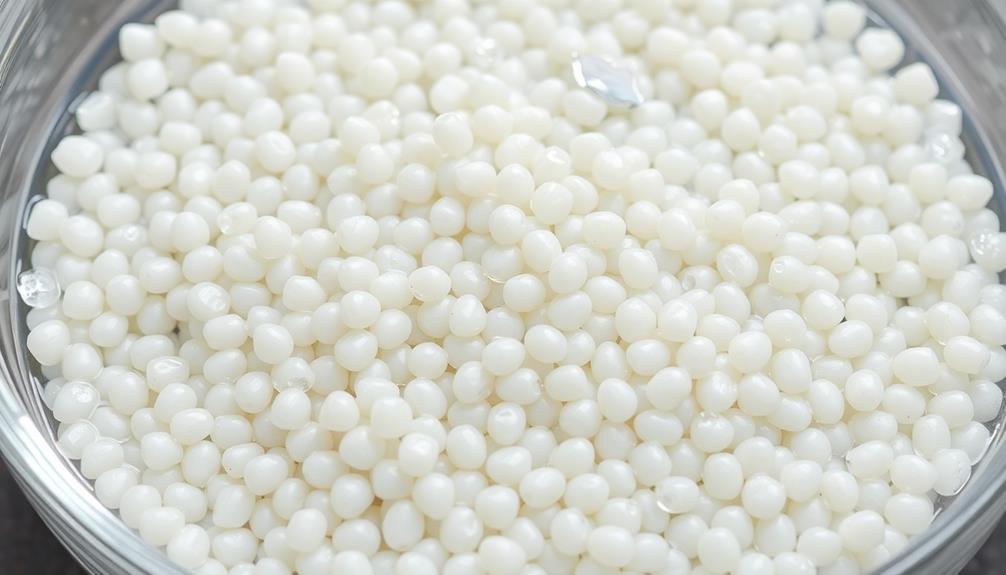
Before cooking the Moghrabieh, you'll need to soak it in water overnight. This simple step is crucial for preparing the Lebanese couscous.
Start by finding a large bowl or container that can hold the Moghrabieh and enough water to cover it completely. Gently place the Moghrabieh grains into the bowl, making sure they're spread out in a single layer. Then, pour in enough water to submerge the couscous fully.
Cover the bowl and let it sit at room temperature overnight, or for at least 8 hours.
The soaking process softens the Moghrabieh, allowing it to cook more evenly later on. It also helps remove any excess starch, resulting in a fluffier texture.
When you're ready to cook, simply drain the Moghrabieh through a fine-mesh sieve or colander. Give it a gentle rinse under cool running water, and it's all set for the next steps in the recipe.
With this simple overnight soak, you'll be well on your way to enjoying delicious, authentic Moghrabieh.
Step 2. Drain and Rinse Moghrabieh

After soaking the Moghrabieh overnight, you'll need to drain and rinse it before proceeding with the cooking steps. This is an important step to remove any excess starch and dirt that may have accumulated during the soaking process.
To do this, simply pour the Moghrabieh into a fine-mesh strainer or colander. Run cold water over the grains, gently stirring and agitating them to ensure they're thoroughly rinsed. You may need to do this a few times to get them completely clean.
Once the Moghrabieh is rinsed, give it a final shake to remove any remaining water. Be careful not to squeeze or press on the grains, as this can cause them to become compacted.
With the Moghrabieh now drained and rinsed, you're ready to move on to the next step in the cooking process. This extra attention to detail will help ensure your Moghrabieh turns out light, fluffy, and full of delicious flavor.
Step 3. Sauté Onions, Garlic, and Spices
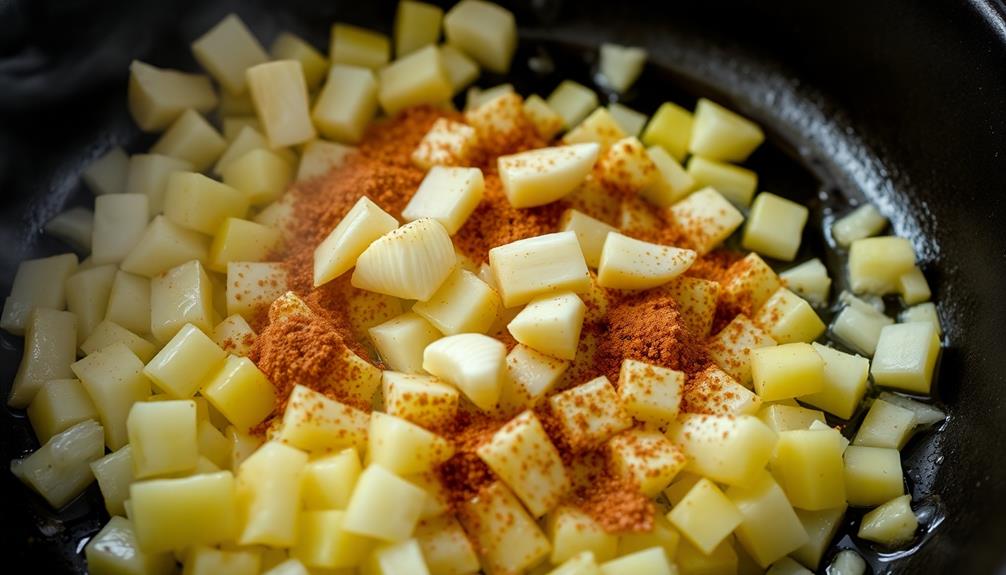
Now that you've rinsed the Moghrabieh, let's start sautéing the onions, garlic, and spices. In a large skillet, heat a couple tablespoons of olive oil over medium heat.
Once the oil is shimmering, add the diced onions and sauté them for about 5 minutes, stirring occasionally, until they start to soften and turn golden brown.
Next, toss in the minced garlic and continue cooking for another minute or two, until the aroma becomes irresistible.
Now it's time to add the flavorful spices – a teaspoon each of cumin, coriander, and cinnamon. Stir everything together and let the spices toast for 30 seconds to a minute, allowing their essential oils to bloom.
The key is to cook the aromatics slowly and gently, coaxing out their sweetness and depth of flavor.
Once the onions and garlic are nicely caramelized, you're ready to move on to the next step. Get excited, because the best is yet to come!
Step 4. Add Chickpeas
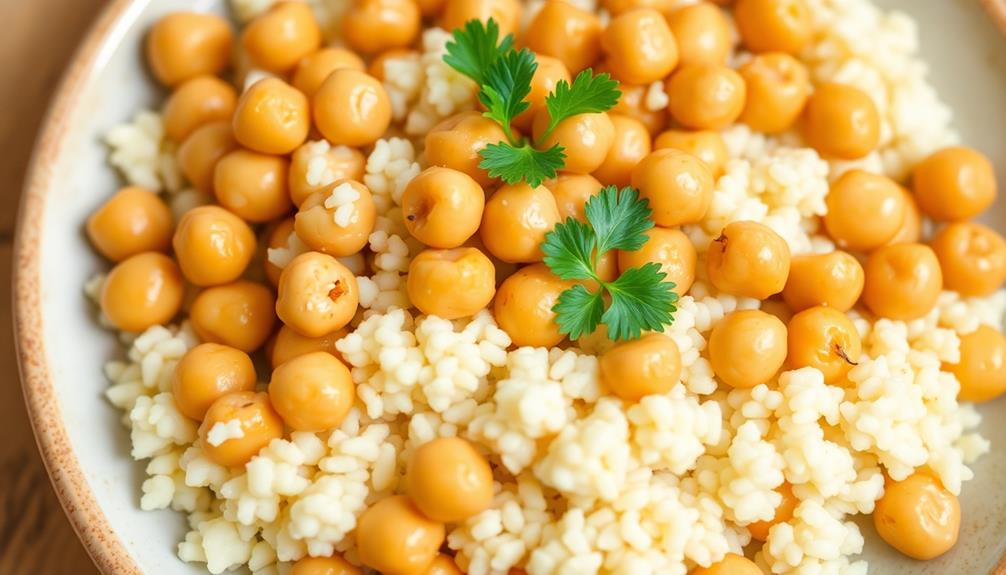
With the aromatic onions and garlic sizzling, it's time to add the chickpeas. These little legumes are packed with protein, fiber, and nutrients that will make your dish even more delicious and satisfying.
Carefully pour the drained and rinsed chickpeas into the pan, mixing them gently with the fragrant onion and garlic mixture. The chickpeas will soak up all those wonderful flavors, creating a harmonious blend of textures and tastes.
As the chickpeas heat through, you'll notice they start to soften and become slightly creamy. This is the perfect time to season them with a pinch of salt and a sprinkle of the spice blend you used earlier.
The warmth will help the seasonings meld together, infusing the chickpeas with even more layers of flavor.
Stir the chickpeas occasionally, making sure they're evenly coated in the spices and cooked through. Once they're heated all the way through, your Moghrabieh dish is ready for the next step!
Step 5. Add Cooked Moghrabieh to Chickpeas
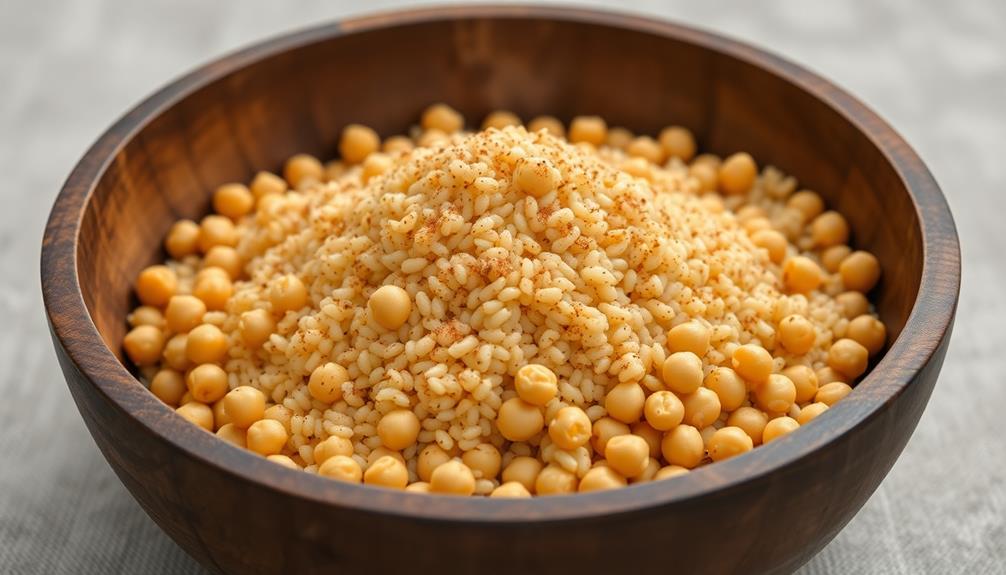
With the chickpeas now infused with the aromatic flavors, it's time to incorporate the cooked moghrabieh. Simply add the tender, pearl-like moghrabieh to the chickpeas and gently stir to combine. The couscous will soak up all the delicious juices, creating a harmonious blend of textures and tastes.
Next, you'll want to heat the mixture through, allowing the flavors to meld. Stir occasionally and keep an eye on it, so nothing sticks to the bottom of the pan. The moghrabieh should warm through without becoming too dry or mushy.
Once everything is heated through, you're ready to serve this vibrant, Middle Eastern-inspired dish. Feel free to add a sprinkle of fresh parsley or a squeeze of lemon juice to brighten up the flavors even more.
The combination of tender chickpeas and the delicate, chewy moghrabieh will delight your taste buds and transport you to the bustling markets of Lebanon.
Final Thoughts
Though moghrabieh may not be as well-known as other Lebanese dishes, it's a delightful and unique offering that's worth exploring. This couscous-like grain has a wonderful, chewy texture and a slightly nutty flavor that pairs beautifully with the savory chickpeas and aromatic spices.
Once you've mastered the basics of cooking moghrabieh, the possibilities are endless. You can enjoy it as a side dish or experiment with different mix-ins and toppings to create a satisfying main course.
The subtle flavors of moghrabieh make it a versatile ingredient that can be dressed up or down to suit your taste.
Frequently Asked Questions
How Long Does Moghrabieh Take to Cook?
Ah, the cooking time for this delicious dish! It typically takes around 20-25 minutes to cook.
You'll want to bring a pot of water to a boil, then gently simmer the couscous until it's tender and fluffy. Be sure to stir it occasionally so it doesn't stick.
Once it's cooked through, you can dress it up with your favorite veggies, spices, or proteins. Yum! Get ready for a tasty and satisfying meal.
Where Can I Buy Moghrabieh Ingredients?
You can find the ingredients for moghrabieh at your local Middle Eastern grocery store or online specialty shops.
They'll have the large, pearl-like couscous grains, as well as any other spices or seasonings you might need.
Don't be afraid to ask the staff for help – they'll be happy to point you in the right direction so you can whip up an authentic Lebanese dish at home.
With a few simple ingredients, you'll be on your way to a delicious moghrabieh feast!
Is Moghrabieh Gluten-Free?
Is Moghrabieh gluten-free? Great question! The answer is, it depends.
Moghrabieh, also known as Lebanese couscous, is a type of pasta made from semolina flour. This means it does contain gluten.
However, you can find gluten-free versions of moghrabieh that are made with alternative flours like rice or corn.
So if you're looking for a gluten-free option, just be sure to check the ingredients.
Either way, moghrabieh is a delicious and versatile ingredient to enjoy!
Can I Make Moghrabieh Ahead of Time?
Yes, you can absolutely make moghrabieh ahead of time!
This Lebanese couscous dish is super versatile and keeps well in the fridge for up to 5 days. Just cook it up, let it cool, and store it in an airtight container.
When you're ready to enjoy it, you can simply reheat it or even serve it cold.
It's a great make-ahead option that'll save you time on busy days. Give it a try – your future self will thank you!
How Do I Store Leftover Moghrabieh?
To store your leftover moghrabieh, you've got a few tasty options!
First, you can pop it in the fridge for up to 4 days. When you're ready to enjoy it again, just reheat it on the stovetop with a splash of water to keep it nice and moist.
Or, you can even freeze it for up to 3 months. Just thaw it overnight in the fridge before reheating. Easy peasy!
Your delicious moghrabieh will be good as new.
